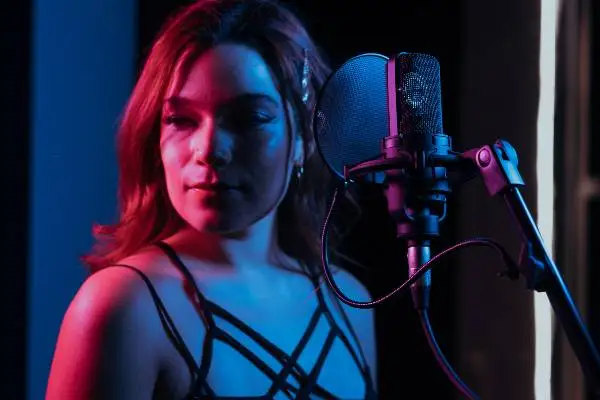For some people, singing comes naturally. Others need to put in time and training to figure out how to properly use their voice. Whatever camp you're in, it's essential to understand the different types of singing voices so that you can make the most out of your vocal range.
Below, we'll detail everything you need to know about the different singing voice types, demystify vocal vocabulary, and share some vocal technique tips so that you can improve your singing voice for the better. Let's jump into it!
Determining Your Vocal Quality
We are all able to notice certain things about our voices. For example, you may observe that you have a deeper voice type than your friend, or perform better when belting versus singing softly. However, there's a lot more to both male voice and female singing voice types. Professional vocalists evaluate their singing voice based on a number of factors including:
- Vocal Range: Your vocal range is essentially the distance from your lowest note to your highest note. A vocal range can be expanded over time to help you hit lower or higher notes with proper training.
- Weight: The heaviness or thickness of your voice. A heavier or lighter vocal weight may lend itself to certain types of music.
- Tessitura: This is your ideal vocal range or the part of your range where your voice feels the most comfortable or natural.
- Timber: Timber refers to the texture or quality of your voice.
- Physical characteristics: The physical structure of your vocal cords and vocal folds influences your particular voice type and overall vocal quality.
- Transition Points: These are the points which you switch from chest register to middle register, to your higher head voice. Vocal transition points can be helpful to identify in order to find the most comfortable sections of your voice.
- Vocal Register: A vocal register is a range of tones produced by a particular configuration of the vocal folds in your vocal cords. Each vocal register has specific vocal qualities that are unique to that register. Some common examples include head voice, mixed voice, chest voice, vocal fry, whistle tones, and falsetto.
- Speaking Voice: This is your resting speaking vocal quality.
While these terms are helpful to understand, it's often best to find a professional vocal teacher to help you properly categorize your own voice. It can be difficult for us to have an unbiased view of our own vocal ranges, so having an outside source can be one of the most useful tools for your current and future vocal development.

Understanding Different Singing Voice Types
Each of the qualities listed above helps us to put our voices within a certain singing voice type. Understanding singing voice types can make it easier for you to find a part in a choir that suits you or craft music around your particular voice type.
Bass Voice
The bass sings as the lowest voice type out there and is performed by male voices since they naturally have a lower vocal range. A bass voice range's tessitura is usually around notes E2 to E4 (using middle c as the frame of reference), giving them a vocal range of about two octaves.
Real bass singers are somewhat rare and difficult to come across, as even male voice types tend to have voices fall in a slightly higher singing range. Some of the most famous bass voices include Barry White and Bing Crosby. You'll find that singers that meet this voice classification are sometimes referred to as bass-baritone singers since their upper range has a similar vocal range to the baritone voice type. This low voice is often used to convey nobility or wisdom.
Baritone Voice
The baritone voice singer's voice type is higher than baritone but has a lower range than the tenor. A typical baritone range rests with a tessitura from A2 to A4, though the dramatic baritone may be able to share some of the lower notes found in a baritone and bass vocal range. In opera, this vocal type often represents a comedic, heroic, or dramatic role. Some modern baritone singers that may come to mind include Hoizer or John Legend.
Tenor Voice
Tenors are a more common vocal range for male voices, with a lighter vocal weight than baritone and bass singers. This male voice type has a comfortable range around C3 and C5, surrounding middle c. A tenor sounds higher in speaking and singing than the baritone and bass, and their voices can be seen all throughout popular music today. The tenor male voice is typically the highest male voice in an opera setting, it is often used for the hero or romantic interest. They are often responsible for carrying the melody as the male voice in music. You might recognize tenor voices in popular music from male voices like Sam Smith and Steve Wonder.
Countertenor Voice
The countertenor voice is the highest male voice, sharing vocal range with female voices. These singers are rare with their most comfortable voice range around E3 to E5. You may mistake these particular tenor voices for female voices. It's possible for young boys to start with a countertenor voice range and then transition to tenor or baritone over time. It can be difficult to find a true classical countertenor voice, though today, those with a strong falsetto may produce a similar vocal quality as seen with pop singers like Bruno Mars or Alfred Deller.
Contralto Voice
The contralto voice is the lowest female voice type. The sweet spot for this singer's voice type is usually between E3 to E5 which notably shares a similar range as countertenor voice. You'll find that the contralto voice has a heavier vocal weight and sits as a middle-range voice type, usually supporting higher voices. It has a darker timber than other female voice types giving it plenty of power. Some examples include Cher and Tracy Chapman. Contralto voices may find it easier to belt than higher, soprano voices.
Alto Voice
This is the second lowest of female singing voice types, still providing plenty of depth and vocal weight with Messituras of F3 to F5. Some altos can expand their range into their higher register with training, sharing some of the same notes as sopranos. While the term "alto" is now used as a more general term to categorize a lower female singing voice, you can find plenty of examples of songs performed within an alto vocal range including "Rehab" by Amy Winehouse.
Mezzo Soprano Voice
A mezzo soprano voice can be equated to the female voice type of the male baritone. This midrange voice is lower than the typical soprano voice and often shares range with the vocal registers of altos and sopranos. They tend to have lighter vocal weight and tone than altos with a tessitura around A3 to A5. In the opera, this voice category is often used to portray boys or young men, even though soprano mezzo is carried out by female voices. These warm voices are popularized by artists like Lady Gaga and Christina Aguilera.
Soprano Voice
The high vocal range rests with soprano signers. A typical soprano voice lies with a tessitura around middle C to C6. This voice type is known for creating bright, dreamy, crystal vocal expressions with expert attuned pitch. Sopranos usually carry the melody of a song, supported by backing voices of altos and other vocal types. In operas, the soprano is usually cast as the heroine, portraying innocence and youth. Modern examples of soprano singers include Ariana Grande and Whitney Houston.
Coloratura Soprano
This is the highest singing voice of all choral music vocal types, sharing the vocal qualities of a soprano voice, but with thick vocal cords to perform impressive opera runs and thrills. Coloratura sopranos are rare though you can find a couple of contemporary music vocalists who might fall into this vocal category. Mariah Carey might be the most likely to earn this coloratura soprano distinction, as exemplified by her ability to sing high notes and runs effortlessly throughout her pop music career.

How Does Singing Work?
So, what exactly happens when we sing? Taking the time to understand the science behind your voice can make it easier for you to understand how you can improve your vocal range over time.
All singing can be traced back to the power of breath. Since singing is produced by the vibration of airflow past our vocal cords, if there's no breath, there's simply no sound! When we breathe in to sing, we take in air from our diaphragm and control the air as we exhale, producing a vocal tone.
Our essential vocal components are housed in the larynx and are referred to as the vocal folds. The vocal folds are made up of individual ligaments that vibrate to create sound. It's worth noting that these vocal folds can deteriorate over time which is why so many famous singers have to undergo surgery or other treatments to deal with their vocal trauma.
Like an athlete, trained vocalists are able to gain control over the muscles in the larynx, effectively producing better pitch and tone quality over time.
However, some people are simply built with stronger singing voices. The mouth, throat, and nasal cavity's anatomy also play a part in vocal tone and structure since they serve as a passageway for the air vibrating your vocal folds.
Thankfully, many people can improve their vocal range and vocal quality with practice and training. A lot of "good" singing breaks down to the ability to emulate the true tone quality of notes, and with training, this process will undoubtedly become easier.
Breaking Down The Vocal Registers
There are several vocal registers that singers fluctuate between depending on a piece of music. Here are some of the most common vocal registers and what you might expect from each of the sections of your voice.
Vocal Fry
Vocal fry is the lowest vocal register that shortens vocal folds without a lot of airflow, causing the listener to hear the vocal folds intersect with one another. This isn't a traditional vocal register, but it's used sometimes in more contemporary music, so it's worth mentioning. Vocal fry can also be known as the pulse register or glottal scrape.
Chest or Modal
Chest or modal voice is your comfortable singing voice and range that allows you to produce tones without having to add air or falsetto to supplement or support your voice. The chest voice's timbre is typically darker and warmer than the higher vocal registers, carrying a bit more vocal weight.
Mixed or Middle Voice
This is the in-between of your chest voice and head voice. You may start to hear some breathier tones intertwined with your chest voice. It's darker than your head voice, but a bit brighter than your modal voice.
Head
This is the high end of your vocal range, characterized by higher pitches and elongated vocal folds. It is your higher, brighter voice that can be carried downwards in pitch, though oftentimes it makes sense to opt for chest voice if you're within a deeper range.
Falsetto
When vocal cords are long, thin, and motionless, singing above a vocalist's usual or modal range. While this isn't necessarily a vocal register (depending on who you talk to) it certainly has a specific tonal quality worth acknowledging.
Whistle
These tones are extremely bright where the vocal cords are closed, with only a tiny portion vibrating, creating a shrill, high-pitched sound. Typically, whistle tones are performed by only a select female voice type with an impressive higher tone.
Oftentimes, professional vocal coaches will focus singers on creating a smooth blend throughout the vocal registers. It can also help to be able to identify which part of the vocal register you're in so that you can adjust your signing approach for as much vocal support as possible.

Musical Glossary
As you grow in your journey as a singer, you're sure to come across some of these terms. Here are some of the most important vocabulary terms you'll want to know as it relates to you as a singer.
Accelerando
This is the gradual speeding of the tempo in a choir or ensemble.
Allegro
Allegro is a musical quality, presenting as fast and lively.
Alliteration
Repetition introduced at the beginning of adjacent words helps make a song or phrase more memorable.
Andante
Adante means moderately slow time.
Aria
An aria is a song in an opera intended for a single voice.
Bar
A division of music coming at the end of a measure in sheet music.
BPM
BPM stands for beats per minute and is one of the ways tempo is measured, particularly in Western music.
Bel Canto
An operatic style known for displaying vocal technique. This phrase translates to, "beautiful singing".
Chord
A group of harmonious notes, usually consisting of at least 3 independent tones.
Chorus
A group of multiple singers, usually consisting of multiple vocal parts.
Coloratura
A singer who specializes in particularly athletic music full of thrills and runs.
Composer
The creator or writer of music.
Concerto
A composition designed for one or more solo instruments.
Conductor
A leader of the orchestra, otherwise known as maestro.
Crescendo
To become progressively louder.
Decrescendo
To become progressively quieter.
Duet
A composition intended for two performers.
Dynamics
Variations in volume throughout a piece of music.
Ensemble
Music written for a group of musicians.
Flat
A half step lower than the natural version of a note.
Forte
This translates to "loud".
Fortissimo
This is a dynamic marking for "very loud".
Harmony
When two or more independent tones are played at the same time, typically with a sonically pleasing interval like a major third or perfect fourth.
Key
The family of notes in which a piece of music resides. Distinguished in the key signature at the beginning of a piece of music.
Largo
Referring to a slow style.

Lyrics
Sung words of a musical composition.
Natural
The natural form of a note, as opposed to a sharp or flat.
Octave
A note that's twice as high or low in pitch as another. A higher or lower tone using the same note.
Opus
A composition that is numbered as a series in a composer's works.
Pianissimo
Translates to "very quiet" in relation to a song's dynamics.
Pitch
The highness or lowness of any particular tone.
Presto
Presto means "very fast" in regards to pacing direction.
Rallentando
To get slower.
Ritard
Ritard or ritardando equates to the gradual slowing of tempo in a piece of music.
Staccato
Each note is performed separately, short and independent of one another.
Trill
Alternating pitch in between two notes.
Tutti
Translates to "all", as to ask all voice types on a composition to sing together.
Vibrato
The vibration that naturally occurs with some singing voices.
How To Determine Your Vocal Range
One of the best ways to narrow down the voice types in order to find your own is to take the time to determine your vocal range. Thankfully, you can do so with a couple of minutes of your time and a little bit of singing:
Since vocal range is the distance between your lowest and highest note, you simply have to determine where these points are. To do this, go to a piano and start at middle C or C4. From there, play notes progressively down, singing their pitch one at a time. Once you can't go any further, you reached the lower end of your range. Mark that note and return to middle C.
Next, repeat the process, but this time moving up in pitch from middle C until you can't sing the high notes of the higher keys. This is the upper limit of your range. Now that you have your lower and higher notes, you should have your vocal range!
If you don't have a piano handy, you can use a video tool like this one as a pitch reference:
Try to be as honest with yourself as possible. Having an inaccurate representation of your vocal range won't help you improve and can put you in a voice types category that is not well suited for your voice. For a more automated approach, you can also test your range and track progress through iOS apps like Singer's Studio.
If you can't tell if you're hitting the pitch or the notes, be sure to enlist in a trusted friend for help. Remember that great vocals take a lot of work to pull off-- Don't be embarrassed if you're not Whitney Houston from the start!
Remember that your vocal range can vary based on a variety of factors, so on any given day, your vocal range may be different. However, your home base or ideal vocal sweet spot will remain largely the same. With practice and training, you should be able to expand your initial vocal range over time.
How To Expand Your Vocal Range
Thankfully, with proper training and practice, your vocal range can grow and expand over time. Here are some ways you can help build your vocal range over time.
1. Practice good posture. Something as simple as proper posture can surprisingly have a great effect on your overall vocal quality and tone. Stand up straight, with your feet planted a shoulder-width apart. Keep your shoulders back and try to keep your head straight while singing.
2. Work with a vocal coach. Since so much of our voice type and natural singing ability is highly personalized, it only makes sense to take an individualized approach to build up our voices. If you're serious about training your voice for the better, consider investing in trained vocal instruction, or at the very least, joining a community choir.
3 . Breathe from the diaphragm. While singing, you should see your diaphragm expand and contract, not your shoulders take in air, and put it out. Focus on taking in air properly. Even committing to something as simple as breathing exercises can help improve your vocal control and tone over time.
4. Practice! If you're not singing, you're not familiarizing yourself with your voice for the better. While there is something to be said about vocal rest, it's wise to sing along to references so that you can start to get an idea of where your weak points are. Focus on matching your pitch with your reference tracks and take the time to warm up before reaching for those higher notes.
5. Relax your jaw. As we reach for high notes, our vocal cords stretch to produce a higher tone. Therefore, relaxing your jaw can provide your singing voice with the room it needs to hit those higher pitches properly. Allow your soft palette to drop and let your mouth elongate, but keep your head steady. You shouldn't need to move your head down or up in order to reach a strong pitch.
6 . Take care of your voice. A lot can show up on the microphone. Since you are your own instrument, in order to expand your vocal range, you need to take care of yourself physically throughout your singing career. This means taking the time to warm up before singing, using vocal exercises, practicing, but also things like getting enough sleep, staying hydrated, and being patient. If you have a big vocal performance on the horizon, it can also be wise to avoid carbonated drinks and dairy products that may cause mucus build-up.
Regardless of your voice type, learning to sing properly can take time. Anyone can sing, but only trained vocalists understand how to make the most out of their singing voice type. Be sure to pay your vocals the same attention as you would with any other instrument. With a little bit of consistent practice and training that's suitable for your singing voice type, you'll improve your vocal quality in no time at all. Above all, enjoy learning and practicing the art of singing!





